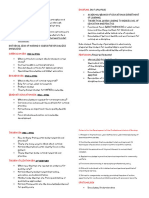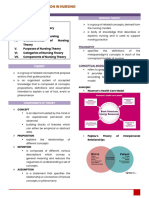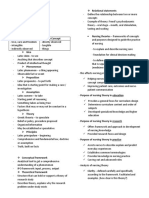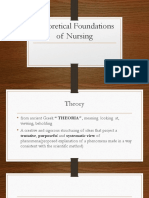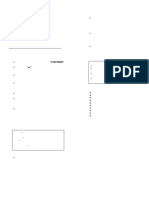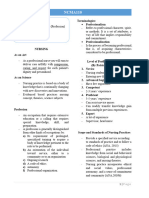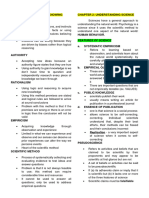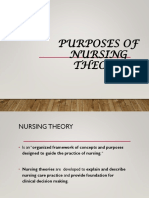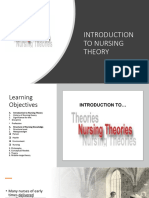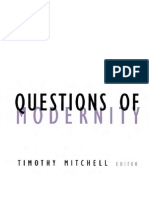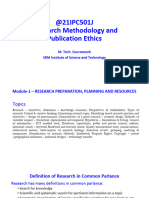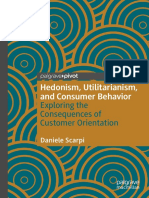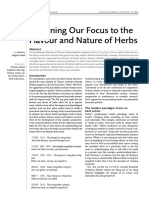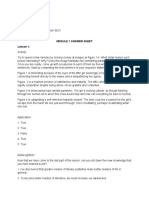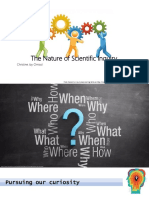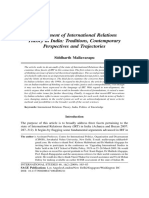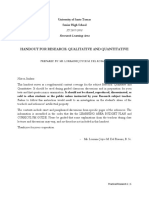TFN (Intro)
TFN (Intro)
Uploaded by
sabrinaCopyright:
Available Formats
TFN (Intro)
TFN (Intro)
Uploaded by
sabrinaOriginal Description:
Original Title
Copyright
Available Formats
Share this document
Did you find this document useful?
Is this content inappropriate?
Copyright:
Available Formats
TFN (Intro)
TFN (Intro)
Uploaded by
sabrinaCopyright:
Available Formats
INTRODUCTION TO TFN
History of Nursing Theory
▪ This was dated way back when
Florence Nightingale began to
assume the great significance of
providing a clean and healthy
environment to achieve recovery
of patients and continues up to
present.
▪ She also envisioned nurses as a
body of educated women who
organized service and caring for
wounded in wartime (Crimean
War) and establishment of
Nursing school in London (St.
Thomas Hospital) pioneering
activities in nursing practice and
education.
▪ Nursing evolved through different
eras. Profession did not start as
what it seemed to be. It started
as a vocational course offering
only skills during their time.
Nursing as a Science:
Apprenticeship Model
✔ Nursing practice was based on
principles and traditions that
were handed down through
practice seen by Florence during
her time.
✔ Other references note that this is
a practice era dated before the
curriculum era where to be a
nurse can have a diploma for
only 2 years under vocational.
✔ Knowledge of persons, health
and environment forms the basis
Fawcett classified nursing models as
for nursing as a discipline
paradigms with in a more organized /
specialized ✔ Kuhn – stated, “the study of
paradigms is what mainly
meta- paradigm of:
prepares the student for
▪ Person membership in a particular
scientific community with which
▪ Health
he / she will practice. By studying
▪ Environment and practicing with them, the
clients or community involved
▪ Nursing Concepts learn their trade."
Profession
Significance of Nursing Theory:
✔ Refers to a specialized field of
At the beginning of the 20th century, practice founded on the
nursing was not recognized as an theoretical structure of the
academic discipline or a profession. The science or knowledge of the
accomplishments of the past century discipline and accompanying
led to the recognition of nursing in both practice abilities.
areas. The terms discipline and
✔ Knowledge of that discipline and
profession are interrelated and some
accompanying practice abilities.
may even use them interchangeably;
however, they are not the same. It is ✔ Recognition and respect for their
important to note their differences and scholarly disciplined contribution
specific meaning. to the health of society.
Discipline Criteria for the Development of the
Professional status of Nursing:
✔ Specific to academia and refers
to a branch of education, a 1. Utilizes in its practice a well-
department of learning or a defined and well organized body
domain of knowledge. of specialized knowledge.
✔ Branch of education; theoretical 2. Constantly enlarges the
works leading to higher level of knowledge it uses and improves
education and practice. its techniques of education and
service thru scientific method.
✔ Functional Focus (what nurses
do) – knowledge focus or what 3. Entrusts the education of its
nurses know and how they use practitioners to universities/
them for thinking and decision colleges.
making while taking care of a
patient. (example: Nursing)
4. Applies knowledge in practical Philosophical Foundations of Science:
services important to community
Rationalism
welfare.
• Priori reasoning -utilizes
5. Functions autonomously in
deductive; cause to effect or
developing professional policy.
general to particular
6. Attracts individuals with
• Use use of the rational senses in
intellectual and personal qualities
ensuring the truthfulness of a
of intensifying service.
phenomenon
7. Strives to compensate nurses by
• Understand the whole first before
providing freedom of action,
you can appreciate the lesser
opportunity for continuous
parts
professional growth and
economic security. • Regards reason as the chief
source & test of knowledge
• Any view appealing to reason as
Historical Views of the Nature of Science
a source of knowledge or
Epistemology (episteme – knowledge; justification (theory-the-research
logos – study of) approach)
● meaning knowledge, • Criterion of truth is not sensory but
understanding intellectual & deductive (general
to specific)
● concerned with the theory of
knowledge in philosophical • ex: lack of social support will lead
inquiry or how knowledge came to hospital readmission, "not all"
to be.
Empiricism
● What is real is also considered
• Way of looking at reality using the
knowledge.
five senses.
● Branch of philosophy concerned
with the nature & scope of • An object is real in so far as seen,
knowledge. felt, smelled, tasted, heard
● It is the study of knowledge & • A theory which states that
justifies beliefs. knowledge comes only or
primarily from sensory experience
● It questions what knowledge is &
how it can be acquired. • Fundamental part of scientific
method
● This aims to discover the meaning
of knowledge, & called it the true • (experimentations)
beginning of philosophy. • Knowledge is based on
experience; ex. physical
assessment
• Gather information more and ✔ Empiricists view phenomena
observe facts before finally objectively, collect data and
saying a theory exists. analyze it to inductively propose
theory.
• Reynolds, “research-then-theory
strategy” Interdependence of theory and
research
• It is inductive. (specific to
general) ● In constructing theory, theorists
must be knowledgeable about
• ex: collect date - diagnose
available empirical findings and
History of Nursing Science: able to take these into account,
because theory is concerned
Early 20th century views
with organizing and formalizing
● Positivism emerged as the available knowledge of a given
dominant view of modern phenomenon.
science.
● The theory is subject to revision or
● Modern logical positivists maybe abandoned in favor of
believed that empirical research an alternative explanation for
and logical analysis were two new information.
approaches that would produce
Science as a social enterprise
scientific knowledge.
● “Human beings do science" -
✔ Philosopher focused on Gale. It might be anticipated
the analysis of theory that social, economic, or political
structure. factors may influence scientific
✔ Scientists focused on enterprise. It depends on the
empirical research. funds, popularity of certain
ideologies.
✔ Increasing use of
computers which permits ● Science progresses by the
diversity of dialogue within the
the analysis of large data.
discipline of nursing. The creation
Emergent of science and theory in the of a merged paradigm from
late 20th century many paradigms is debated in
relationship to the advancement
Phenomenological Approach reduces
of nursing.
observations or text to the meanings of
phenomena independent of their
particular context. This approach
focuses on the lived meaning of
experiences.
✔ Several authors presented
analysis challenging the positivist
position, thus offering the basis for
a new perspective in science.
Categories of Theory Components:
10 Phases of Concept Building Process: Linkages of theoretical statements
1. Write a meaningful practice story. - vide rationale of why theoretical
statements are linked; add
2. Name the central phenomenon
- plausibility
in the practice story.
Linkages of operational statements
3. Identify a theoretical lens for
viewing the phenomenon. - provides rationale for how
measurement variables are
4. Link the phenomenon to existing
linked;
literature.
- permit testability
5. Gather a story from someone
Organization of concepts and
who has lived the phenomenon.
definitions into primitive and derived
6. Reconstruct the shared story and terms
create mini-saga that captures its
- eliminates overlap (tautology)
message
Organization of statements and
7. Identify the core qualities of the
linkages into premises and derived
phenomenon.
hypotheses and equations
8. Use the core qualities to create a
- eliminates inconsistency
definition.
Scientific Laws
9. Create a model of the
phenomenon ✔ A statement of fact that aims to
10. Write a mini synthesis that explain, in brief and simple terms,
integrates the phenomenon with an action or set of actions
a population to suggest research ✔ Generally accepted to be true
direction. and universal and can
Rational Statements occasionally be expressed in
terms of a single mathematical
- Statements in a theory may state equation
definitions or relations among
concepts ✔ SIMPLE, TRUE, UNIVERSAL &
ABSOLUTE
Theoretical Statements
✔ Governs a single action,
- Relate concepts to one another; foundations for all science
permit analysis
✔ Statement based on repeated
Operational Statements
experimental observations that
- Relate concepts to describes some aspects of the
measurements universe
Linkages and Ordering: ✔ Always applies under same
conditions, & implies that there is
a causal relationship involving its Contemporary Issues in Nursing
elements
Theory Development:
✔ ex. Law of Universal Gravitation
▪ Theoretical Boundaries and
by Newton
Levels to Advance Nursing
Theory Science
✔ More complex & dynamic; o Proposed framework now used
maybe replaced without reference to the author
for the development of nursing
✔ Explains an entire group science
✔ Can be changed or improved ▪ Nursing Theory, Practice and
without changing the overall Research
truth
o Theory-testing research may lead
✔ Developed from the scientific one nursing theory to fall aside as
method a new theory is developed that
explains nursing phenomena
✔ ACCEPTED AT TRUE & PROVED more adequately; must continue
Hypothesis to advance the discipline.
● an educated guess based upon
observation Nursing Philosophies – sets for the
● can be supported or proven false meaning of nursing phenomena
by experimentation or continued through analysis, reasoning and logical
observation argument. Are works that provide broad
understanding that advances the
● an idea or theory that is not discipline and its professional
proven but leads to further study application.
or discussion
The history of nursing theory was dated
● an assumption made for the sake way back when Florence Nightingale
of argument\ began to assume the great significance
● HAS NOT BEEN PROVED of providing a clean and healthy
environment to achieve faster recovery
● ex. watching excessive amounts of patients and continues up to present.
of TV reduces a person’s ability to
concentrate; smoking leads to
lung cancer
FLORENCE NIGHTINGALE o diseases such as typhus, cholera,
and dysentery were the primary
✔ Nightingale’s (1859-1992) Notes reasons why the death rate was
on Nursing presents the nursing high
theory that focuses on the
manipulation of the environment ▪ She recognized that overcrowding,
for the benefits of the patient. filth, and poor ventilation all contributed
to the illness of the soldiers.
✔ Although Nightingale did not
present her work as a nursing ▪ At night, she carried a lamp through
theory, it has directed nursing the corridors, stopping to help the
practice for over 140 years. She is suffering of the wounded soldiers, for
known as the Mother of Modern this, she was nicknamed, “The Lady with
Nursing. the Lamp”
✔ Daughter of William Nightingale ENVIRONMENTAL THEORY
of Embley Park, Hampshire and “Nursing is the art of utilizing the
was born in Italy, on the 12th day patient’s environment for his or her
of May, 1820. recovery.”
The Crimean War Environment – defined as the external
▪ In March 1853, the Crimean War broke conditions and influences affecting the
out between Russia and Turkey. It was life and development of an organism
during this war where Florence and capable of preventing,
Nightingale volunteered her services suppressing, or contributing to disease,
and was eventually given permission to accidents, or deaths.
take a group of 38 nurses to Turkey. Components of Environment:
▪ She found the conditions as: ▪ Proper Ventilation. Nightingale
o soldiers lay in filth straw pallets in believed that nurses have the
crowded hallways responsibility to keep the air that the
patient breathes pure as the external air
o rats and insects crawled the without necessarily chilling him. She
floors and walls recognized the possibility that
inadequate ventilation may be the
o hospitals lack basic supplies, such
source of disease.
as cots, mattresses, bandages,
washbasins, soap, and towels ▪ Adequate Light. Direct sunlight has
quite as real and tangible effects on the
o water was rationed, and
human body who has not observed the
available in totally inadequate
purifying effect of light, and especially
amounts
of direct sunlight.
o wounded armies were wearing
unwashed uniforms that were stiff ▪ Cleanliness. She advocated taking a
bath daily and that nurses should also
with dirt and gore
bathe daily while keeping their duty
uniforms clean and their hands washed ventilation, promote adequate and
clean. appropriate nutrition, maintain normal
homeostatic body temperature, and
▪ Warmth. Nightingale outlined a
observe basic hygiene and comfort
procedure for measuring the body’s
measures, including environmental
temperature through palpation of, or
sanitations.
feeling for the extremities in order to
assess for heat loss. One of the nurse’s ▪ Nursing Education: Nightingale had
role is to manipulate the environment. established the St. Thomas Hospital and
Positioning the patient, opening the King’s College Hospital in London, which
windows, and regulating the room was able to provide a framework for the
temperature are ways of maintaining establishment of nursing training schools
this balance. through a universal template that
contains principles of nursing training.
▪ Quiet. Nightingale described
She also advocated the separation of
unnecessary noise can actually be
nursing training from the hospital to a
harmful to the patient who is ill. more appropriate learning environment
▪ Diet. Nightingale maintained that one in the school or university setting.
of the nurse’s role is to assess both the ▪ Nursing Research: Nightingale is
meal schedule and its effect on the considered the mother of nursing
patient, in addition to assessing the research because of her interest in the
patient’s dietary intake. scientific methods of inquiry and
▪ Management. The nurse is actually in statistics. She was able to gather and
control of the environment, physically, analyze data efficiently and
and administratively. The nurse is resourcefully. She was the first to use
responsible for controlling the polar diagrams in presenting study data.
environment so that the patient is The concepts of Nightingale’s theory still
protected from physical and serve as a basis for current research. In
psychological harm. the 1990s, research studies that tested
and expanded nursing theory were
➢ Nightingale believed that the numerous.
nurse continuously controlled the
environment even if she is
physically absent from caring for
the patient because she is still
responsible for supervising the
other members of the health
team who worked on her patient
during her absence.
Application to Nursing:
▪ Nursing Practice: Ventilation, warmth,
quiet, diet, and cleanliness are still
important aspects of nursing care. We,
nurses, thus need to maintain adequate
• WATSON'S PHILOSOPHY & THEORY ✔ 2nd book – Nursing: Human
OF TRANSPERSONAL CARING Science and Human Care
– A Theory of Nursing
“Nursing is the human science of
(1985), addressed her
persons and human health – illness
conceptual and
experiences that are mediated by
philosophical problem in
professional, personal, scientific,
nursing
aesthetic, and ethical human care
transactions.” Transpersonal Caring Relationship
▪ foundational of her theory;
it is a special kind of human care
JEAN WATSON
relationship
• born and grew up in a small town
▪ a union with another
of Welch West Virginia; youngest
person-high regard for the whole
of the eight children
person and their being in the
• began developing her theory world
while she was assistant dean of
▪ “Caritas” originates from
the undergraduate program at
the Greek vocabulary, meaning
University of Colorado
to cherish and to give special
• in 1978-1981, she served as loving attention
coordinator and director of the
▪ Watson uses the term “carative”
PhD program
instead of curative
• worked from 11 curative factors
to formulate her 10 carative
factors
• modified 10 factors slightly over
time and developed the caritas
processes, which have a spiritual
dimension and use a more fluid
and evolutionary language
• authorized 11 books which reflect
the evolution of her theory of
caring
✔ 1st book – Nursing: The
Philosophy and Science of
Caring (1979), use 10
carative factors but
evolved to include
“caritas” (connection
between caring and love)
10 Elements of Carative Factors: to engage in artistry of caring-
Watson introduced the concept healing practices.
of clinical caritas process, which 7. Transpersonal teaching
have replaced her carative learning- Engaging in genuine
factors. The following are the teaching-learning experience
translation of the carative factors that attends to unity of being
into clinical caritas processes and meaning, attempting to
stay within other’s frames of
reference.
1. Humanistic-altruistic system of 8. Supportive, protective, and/or
value - Practice of loving corrective mental, physical,
kindness and equanimity (self- societal, and spiritual
control/composure) within environment - Creating a
context of caring healing environment at all
consciousness. levels (physical as well as non-
2. Faith-hope - Being physical), subtle environment
authentically present, and of energy and consciousness,
enabling and sustaining the whereby wholeness, beauty,
deep belief system and comfort, dignity, and peace
subjective life world of self are potentiated.
and the one-being-cared-for. 9. Human needs assistance-
3. Sensitivity to self and others - Assisting with basic needs,
Cultivation of one’s own with an intentional caring
spiritual practices and consciousness, administering
transpersonal self, going “human care essentials”,
beyond ego self, opening to which potentiate alignment of
others with sensitivity and mind-body-spirit, wholeness,
compassion. and unity of being in all
4. Helping-trusting, human care aspects of care, tending to
relationship- Developing and both the embodied spirit and
sustaining a helping-trusting, evolving spiritual emergence.
authentic caring relationship 10. Existential-phenomenological-
5. Expressing positive and spiritual forces - Opening and
negative feelings- Being attending to spiritual-
present to, and supportive of, mysterious and existential
the expression of positive and dimensions of one’s own life-
negative feelings as a death; soul care for self and
connection with a deeper the one-being-cared-for.
spirit of self and the one-
being-cared-for.
6. Creative problem-solving
caring process- Creative use
of self and all ways of knowing
as part of the caring process
Transpersonal caring relationship Theory Assertions
characterizes a special kind of human
care relationship that depends on: ✔ The theory acknowledges the
unity of the person’s mind-body-
▪ the nurse’s moral commitment in spirit.
protecting and enhancing human
dignity as well as the deeper/higher self ✔ The mind is the point of access to
the body and the spirit.
▪ the nurse’s caring consciousness
communicated to preserve and honor ✔ The spirit relates to a person’s
the embodied spirit, therefore, not soul, the inner self, the essence of
reducing the person to the moral status the person, the spiritual self.
of an object
✔ It is the spirit that allows the
▪ the nurse’s caring consciousness and person to transcend the “here
connection having the potential to heal and now” coexisting with past,
since experience, perception, and present, and future, all at once
intentional connection are taking place through creative imagination
and visualization.
✔ Watson ascertains that the care
The term “transpersonal” means to go
of the soul remains the most
beyond one’s own ego and the here
powerful aspect of the art of
and now, as it allows one to reach
caring in nursing.
deeper spiritual connections in
promoting the patient’s comfort and Major Assumptions
healing. Finally, the goal of a
transpersonal relationship corresponds ✔ ▪ Nurse’s ability to connect with
to protecting, enhancing, and another at this transpersonal spirit
preserving the person’s dignity, to spirit level is translated via
humanity, wholeness, and inner means of communication, into
harmony. nursing human art and acts or
intentional caring- healing
A caring occasion is the moment (focal modalities.
point in space and time) when the nurse
and another person come together in ✔ ▪ Caring-healing modalities within
such a way that an occasion for human the context of transpersonal
caring is created. Assistance with the caring/ caritas consciousness
gratification of human needs describes potentiate harmony, wholeness
the role of the nurse in promoting and unity of being by releasing
wellness and health through the some of the disharmony.
achievement of basic human needs ✔ Ongoing personal & professional
according to Maslow’s hierarchy of development and spiritual
needs. growth.
✔ Nurse’s own life history, previous
experiences etc. Are valuable
teachers for this work.
✔ ▪ Other facilitators are personal Implications of the Theory:
growth experiences such as
▪ One major implication of the theory is
psychotherapy and other models
in the realm of bedside nursing where
for spiritual awakening.
nurses of today have particularly begun
✔ ▪ Continuous growth for to neglect. The essence of nursing is in
developing and maturing within the caring aspect and caring is taking
a transpersonal caring model is the wholeness, the totality, of the
ongoing. patient in consideration.
Application to Nursing: ▪ More importantly, nurses of today
should try to care for a patient for who
✔ ▪ Nursing Practice (Administration he is. After all, all of us were created
& Leadership): It calls for equal and in His likeness.
administrative practices and
embrace caring, even in a health
care environment of increased
acuity levels of hospitalized
individuals, short hospital stays,
increasing complexity of
technology, and rising
expectations in the task of
nursing.
✔ ▪ Nursing Education: Watson’s
writings focus on educating
graduate nursing students and
providing them with ontological,
ethical, and epistemological
bases for their practice, along
with research directions. Watson’s
caring framework has been
taught in numerous
baccalaureate nursing curricula.
✔ ▪ Nursing Research: Watson’s
theory to reduce distress
experienced by infertile women.
Her theory and the application of
theory of clinical practice
hospital organizations have been
their major weakness of research.
Nelson and Watson report on
studies carried out in seven
countries.
PATRICIA BENNER: CARING, CLINICAL The Dreyfus Model is situational that
WISDOM AND ETHICS IN NURSING describes the five levels of skill
PRACTICE acquisition and development:
✔ born in Hampton, Virginia ▪ Novice (0 to 1 year)
✔ obtained a ▪ Advanced Beginner (1 to 2years)
baccalaureate of arts
▪ Competent (2 to 3 years)
degree from Pasadena
College in 1964 ▪ Proficient (3 to 5 years) – intuitive
✔ earned Master’s degree in ▪ Expert (>5 years) – clinical eye
Nursing with major
emphasis in medical
surgical nursing from The model proposes that, as a person
University of California, San improves in skill level, there is a
Francisco, School of corresponding change in the
Nursing performance of a given skill. These are:
✔ has a wide range of ✔ Movement from reliance on
clinical experience, abstract principles and rules to
including acute medical- use of past, concrete experience.
surgical, critical care and
home health care ✔ Shift from reliance on analytical,
rule-based thinking to intuition.
✔ noted that experience-
based skill acquisition is ✔ Change in the learner’s
safer and quicker when it is perception of the situation from
founded on a sound viewing it as a compilation of
educational base equally relevant pieces to
viewing it as an increasingly
complex whole in which some
parts stand out as more or less
“Nursing is a caring relationship and
relevant.
practice that cares for and studies the
lived experiences of patients on health,
illness, and disease, and the
relationships among these three Passage from a detached observer,
elements.” standing outside the situation, to one of
a position of involvement, fully engaged
in the situation. Skill refers to nursing
interventions and clinical judgment skills
"The Nurse - Patient Relationship is not a
uniform, professionalized blueprint but in actual clinical situations. Expertise is
rather a Kaleidoscope of intimacy and developed when the clinician tests and
distance in some of the most dramatic, modifies principle-based expectations in
poignant, and mundane moments of the actual setting.
life".
Novice Stage Competent Nurse
▪ characterized by a person who lacks ▪ considerable conscious and deliberate
background experience of the situation planning which determines the
he or she is involved in important aspects of present and future
situations.
▪ in order to guide the performance,
simple rules and objectives, attributes ▪ exhibits a sense of mastery, increased
should be given because the novice will level of efficiency, consistency,
usually have difficulty differentiating predictability, and time management.
relevant and irrelevant aspects of a
Proficient Nurse
situation
▪ already has a holistic view of a
▪ examples are nursing students and
particular situation
professional nurses who have been
assigned to an area totally different ▪ the nurse’s performance is guided by
from the one they are accustomed to maxims by this stage
▪ when the novice has already started ▪ can already show an intuitive grasp of
coping with enough real situations and the situation based on background
has allowed him/her to demonstrate understanding
minimally acceptable performance
within a given situation, his/her skill level ▪ can see changing relevance in a
also advances to that of an advanced given situation including recognition
beginner and implementation of skilled responses
to the situation as it evolves
Advanced Beginner
Expert Nurse
▪ has enough experience to grasp
aspects of a situation but not within the ▪ does not rely anymore on the
context of the situation analytical principles of rules, guidelines,
and maxims to connect her
▪ should be guided by rules and are understanding of the situation to an
oriented by the completion of tasks appropriate action
▪ feels highly responsible for managing ▪ characterized by the following vital
patient care but will still need the help traits:
of other nurses who are more
experienced than her o demonstrate a clinical grasp and
resource-based practice
▪ examples are newly registered
professional nurses o possess embodied know-how
▪ progresses into a competent level of o see the big picture
skill acquisition by learning from actual o see the unexpected
practice situations and by following the
actions of others.
Competency – defined as an phenomenal approaches to
interpretively defined area of skilled nursing practice.
performance identified and described
by its intent, functions, and meanings. ✔ ▪ Phenomenal approaches have
resulted in the development of
clinical promotion ladders, new
graduate orientation programs,
Experience – the active process of
and clinical knowledge
refining and changing preconceived
development seminars.
theories, notions, and ideas when
confronted with actual situations; it ✔ ▪ Her model is instrumental in
reflects that there is communication differentiating knowledge
between what is found in practice and development and career
what is expected. progression in nursing. This
allowed nursing educators to
realize that learning needs at the
Maxim – a mysterious description of early stages of clinical
skilled performance. knowledge development are
different from those required at
✔ It requires a certain level of later or higher stages.
experience to recognize the
implications of the instructions. ✔ ▪ It is important to understand
that different employees will
✔ Paradigm case is a clinical have different levels of skills.
experience that stands out.
✔ ▪ It is important to emphasize the
✔ It alters the way the nurse will importance of learning the skill of
perceive and understand and involvement and caring through
open new clinical viewpoints and practical experience, articulation
alternatives. of knowledge with practice, and
the use of narratives in
undergraduate education.
Hermeneutics – interpretive; it describes
meaningful human activities or ✔ ▪ It is important for nursing
phenomena in a careful and detailed students and professional nurses
manner. alike to learn through experience
or by experiential learning.
✔ The description is free from
analytical assumptions. It is based ✔ ▪ Learning by experience will
purely on practical allow you to gain mastery of a
understanding of the given skill.
phenomena.
Application of the Theory:
✔ ▪ Benner’s contribution to the
nursing profession is the use of
MARILYN ANN RAY disorder. Ray compares change in
complex organizations with this creative
• 1958 – went to LA, CA work at
process and challenges nurses to step
OB-Gyn, ER, CCU
back and renew their perceptions of
• 1960 – US Citizen, US Air Force- everyday events, to discover the
flight nurse, clinician, embedded meanings.
administrator, educator,
Major Concepts & Definitions:
researcher with a rank of
Colonel. The first nurse to go to ▪ Holography – everything is a whole in
the Soviet Union with the one context and a part in another, with
Aerospace Medical association each part being in the whole and the
whole being in the part
• 1965 – BSN-MSN in MCN at the
University of Colorado; Dr. ▪ Caring – a complex transcultural,
Madeleine relational process grounded in an
ethical, spiritual context (charity and
Leininger, a nurse anthropologist,
right action, love as compassion in
influenced Ray's life.
response to suffering and need and
• 1973 – went back to Canada to justice or fairness of what to be done)
be with her family, faculty in
▪ Spirituality – involves creativity
McMaster University
and choice and is revealed in
• 1989 – appointed as an Eminent attachment, love, and community
Scholar at Florida Atlantic
o Spiritual- Ethical caring for nursing
University and continues as
focuses on the facilitation of choices for
Professor Emeritus
the good of others
• Her research interests continue to
▪ Educational – formal and informal
focus on nurses, nurse
educational programs, use of
administrators and patients in
audiovisual media to convey
critical care and intermediate
information and other forms of teaching
care, and in nursing
and sharing information
administration in complex
hospital organizational cultures ▪ Physical – related to the
physical state of being, including
biological and mentalA patterns (mind
Theoretical Sources: and body)
▪ Dr. Leininger – transcultural ▪ Social-Cultural – ethnicity & family
nursing and ethnographic-ethnonursing structures, intimacy with friends and
research methods. family, communication; social
interaction and support.
▪ Hegel – posited the
interrelationship among thesis, antithesis, ▪ Legal – meaning of caring include
and synthesis. responsibility and accountability; rules
and principles to guide behaviors such
▪ Chaos Theory – describes simultaneous
order and disorder, and order within
as policies, procedures informed reflects the holistic nature of the theory.
consent; right to privacy This shows that nurses, patients, and
administrators value the caring
▪ Technological – nonhuman resources,
intentionality that is co-created in the
like machinery to maintain the
nurse-patient or administrator-nurse
physiological well-being of the patient,
relationship. This can transform the
diagnostic tests, knowledge and skills
working environment, fostering ethical
needed to utilize these resources
choices, respect, and trust, resulting to
▪ Economic – includes money, budget, successful organizations
insurance systems, limitations and
▪ Nursing Education: Useful in nursing
guidelines imposed by managed care
education in terms of its broad focus on
organizations, allocation of human and
caring in nursing and its
material resources to maintain services
conceptualization of the health care
▪ Political – power structure within health system. Interconnectedness of all things
care administration, pattern of decision ▪ Nursing Research: Particularly
making in the organization; role and significant because it is grounded in the
gender stratification among health care philosophy of humanism and caring,
providers; competition for scarce and it encourages nurses to utilize
human and material resources phenomenological-hermeneutics
through the lens of caring
Major Assumptions:
▪ The meaning of caring is highly
differential, depending on its structures
(social-cultural, educational, political,
economic, physical, technological,
legal)
▪ Caring is bureaucratic as well as
spiritual/ ethical, given the extent to
which meaning can be understood in
relation to the organizational structure
▪ Caring is the primordial construct and
consciousness of nursing
Application to Nursing:
▪ Nursing Practice (Administration &
Leadership): The theory of Bureaucratic
Caring has direct application for
nursing. We are challenged to integrate
knowledge, skills and caring. This
synthesis of behaviors and knowledge
You might also like
- TFN Transes 1st Term EditedDocument18 pagesTFN Transes 1st Term EditedFaye Hashly AfunggolNo ratings yet
- THEORY DEVELOPMENT in NursingDocument12 pagesTHEORY DEVELOPMENT in NursingMeil Estallo Alarzar75% (8)
- Purpose of Nursing Theories TransesDocument3 pagesPurpose of Nursing Theories TransesJenny Ruth TubanNo ratings yet
- Nursing PhilosophyDocument26 pagesNursing PhilosophyBasil Hameed AmarnehNo ratings yet
- TFN 1-7Document41 pagesTFN 1-7Brianna FlamianoNo ratings yet
- Module 1 - TFNDocument6 pagesModule 1 - TFNLia neNo ratings yet
- Nursing As A Science Apprenticeship Model: DisciplineDocument5 pagesNursing As A Science Apprenticeship Model: DisciplineGensheal IraNo ratings yet
- Session 1 TFN NotesDocument31 pagesSession 1 TFN NotesJannine Veronica Rosario AnchetaNo ratings yet
- TFNDocument5 pagesTFNLetsirk EamNo ratings yet
- 1tfnDocument5 pages1tfnnantesgwyne12No ratings yet
- TFN ReviewerDocument18 pagesTFN ReviewerJhae Zharie Delasan PanosoNo ratings yet
- TFN Chapter1Document4 pagesTFN Chapter1Sung Joong RaNo ratings yet
- Evolution of Nursing TheoriesDocument79 pagesEvolution of Nursing Theorieschairul munirNo ratings yet
- TFN DraftDocument8 pagesTFN DraftChristine Jade TanNo ratings yet
- TFNDocument7 pagesTFNsaladinoalteah5No ratings yet
- TFN TransesDocument10 pagesTFN Transesrentachin18No ratings yet
- LV1 TFN NotesDocument56 pagesLV1 TFN NotesDigipiks TumauiniNo ratings yet
- Theoretical Foundation OF NursingDocument21 pagesTheoretical Foundation OF NursingilanoelahNo ratings yet
- PST MLS Lesson 2Document2 pagesPST MLS Lesson 2seaynNo ratings yet
- MIDTERMDocument35 pagesMIDTERMrein heeNo ratings yet
- TFN ReviewerDocument12 pagesTFN Reviewerkarenlumao920No ratings yet
- TFN Handouts Midterm and Finals A4Document28 pagesTFN Handouts Midterm and Finals A4ZIAN LABADIANo ratings yet
- 3112 1.1Document12 pages3112 1.1KASSANDRA THERESE G. DAITOLNo ratings yet
- TFN ReviewerDocument8 pagesTFN ReviewerCHESKA LYKA ASILONo ratings yet
- TFN ReviewerDocument9 pagesTFN ReviewerPaul Jean MerinoNo ratings yet
- Nursing Practice Is Based and Provides The Foundation For Understanding Theory As One Type of Nursing KnowledgeDocument32 pagesNursing Practice Is Based and Provides The Foundation For Understanding Theory As One Type of Nursing Knowledgeyousuf pogi100% (1)
- Components of A TheoryDocument10 pagesComponents of A TheoryAlliah CasingNo ratings yet
- NURS 12 - ReviewerDocument8 pagesNURS 12 - ReviewerRina Lyzea PunongbayanNo ratings yet
- Nursing Research I: - LectureDocument3 pagesNursing Research I: - LectureAlyssa MagnayeNo ratings yet
- Research 1 ModuleDocument23 pagesResearch 1 ModuleNina Anne ParacadNo ratings yet
- Theoretical 1Document10 pagesTheoretical 1Shane OseñaNo ratings yet
- Philosophy Science NursingDocument3 pagesPhilosophy Science NursingLassie AbusadoNo ratings yet
- Theoretical Foundations of Nursing PrelimsDocument51 pagesTheoretical Foundations of Nursing PrelimsFev BanataoNo ratings yet
- Humanistic TheoryDocument14 pagesHumanistic TheoryMesh CoyivNo ratings yet
- Nursing As A ProfessionDocument164 pagesNursing As A ProfessionLex Alejandro Jr.No ratings yet
- Nursing Research Complete TransDocument23 pagesNursing Research Complete Transburdeosethan2No ratings yet
- Intro To Nres HandoutsDocument7 pagesIntro To Nres Handoutsjillmonicadaquipil7No ratings yet
- NCM 111 Lec FriDocument12 pagesNCM 111 Lec FriErica Mei CapiliNo ratings yet
- TFN NotesDocument6 pagesTFN NotessalamancacherryloveNo ratings yet
- Theoretical Foundation in NursingDocument52 pagesTheoretical Foundation in NursingXena IngalNo ratings yet
- Cmpa411 Prelim (TFN, Funda, Maternal 217, CHN)Document460 pagesCmpa411 Prelim (TFN, Funda, Maternal 217, CHN)shawdino03No ratings yet
- TFN NOTES FinalDocument36 pagesTFN NOTES FinalAllaika Zyrah FloresNo ratings yet
- Introduction To Nursing TheoryDocument4 pagesIntroduction To Nursing Theorycam broquelNo ratings yet
- Syllabi (100-110)Document99 pagesSyllabi (100-110)Marilou PadilloNo ratings yet
- The Systematic Accumulation of Knowledge Is Essential To Progress in Any ProfessionDocument16 pagesThe Systematic Accumulation of Knowledge Is Essential To Progress in Any ProfessionChona FontanillaNo ratings yet
- Complete Ca1 Prelim ReviewersDocument37 pagesComplete Ca1 Prelim ReviewersANDREW DEL ROSARIONo ratings yet
- Intro To NursingDocument12 pagesIntro To NursingLoe MordNo ratings yet
- B5RESMETDocument21 pagesB5RESMETSandy TafallaNo ratings yet
- NCM100 Reviewer 1 (Prelims)Document18 pagesNCM100 Reviewer 1 (Prelims)Francine Dominique CollantesNo ratings yet
- Recovered File 1Document32 pagesRecovered File 13amabelle arevaloNo ratings yet
- REVIEWERDocument52 pagesREVIEWERSai TrishiaNo ratings yet
- Nursing TheoryDocument4 pagesNursing Theoryfrenzjamborillo338No ratings yet
- Topic 2 - Philosophical Foundations of CurriculumDocument51 pagesTopic 2 - Philosophical Foundations of Curriculumaton hudaNo ratings yet
- Strategies in Health Teaching Chapter 1Document4 pagesStrategies in Health Teaching Chapter 1Sophia Elinor MenesesNo ratings yet
- Lecture 1 - Scholarliness in NursingDocument12 pagesLecture 1 - Scholarliness in NursingCanary KhailNo ratings yet
- Evolution of Nursing Part 2Document50 pagesEvolution of Nursing Part 22058939No ratings yet
- NCM-100-intro-1Document51 pagesNCM-100-intro-1Julia BruselasNo ratings yet
- Becoming a Practitioner Researcher: A Gestalt Approach to Holistic InquiryFrom EverandBecoming a Practitioner Researcher: A Gestalt Approach to Holistic InquiryNo ratings yet
- MS Word in ED 105 (Group 7)Document22 pagesMS Word in ED 105 (Group 7)Christine Joy PerionNo ratings yet
- Sunstein-Vermeule Conspiracy TheoriesDocument27 pagesSunstein-Vermeule Conspiracy TheorieskevinfromexoNo ratings yet
- Wiley The American Society For AestheticsDocument12 pagesWiley The American Society For AestheticsspirospotNo ratings yet
- Philosophy and Development of Education in MalaysiaDocument12 pagesPhilosophy and Development of Education in MalaysiaAbdul Ghaffar JaafarNo ratings yet
- Active TheoryDocument3 pagesActive TheoryWinnie Chelagat Makena100% (1)
- Dissertation - Moby Dick Vs The Old ManDocument156 pagesDissertation - Moby Dick Vs The Old Manpeterson_parker100% (1)
- Alderson Wroe 1957 - Marketing Behavior and Executive Action A Functionalist Approach To Marketing Theory byDocument4 pagesAlderson Wroe 1957 - Marketing Behavior and Executive Action A Functionalist Approach To Marketing Theory by19337100No ratings yet
- Questions of Modernity Contradictions of ModernityDocument258 pagesQuestions of Modernity Contradictions of ModernitySentaru Dragos75% (4)
- JurisprudenceDocument12 pagesJurisprudenceMazhar AliNo ratings yet
- UNIT-1Document129 pagesUNIT-1Arun TrentNo ratings yet
- Thinking Strategically by Avinash DixitDocument13 pagesThinking Strategically by Avinash Dixitrupesh2241100% (1)
- Daniele Scarpi - Hedonism, Utilitarianism, and Consumer Behavior - Exploring The Consequences of Customer Orientation (2020, Palgrave Macmillan)Document207 pagesDaniele Scarpi - Hedonism, Utilitarianism, and Consumer Behavior - Exploring The Consequences of Customer Orientation (2020, Palgrave Macmillan)nora lizaNo ratings yet
- Flavors and Nature of Herbs - Chinese MedicineDocument7 pagesFlavors and Nature of Herbs - Chinese MedicinescumsNo ratings yet
- Research GapDocument3 pagesResearch GapChetan AcharyaNo ratings yet
- Theoretical Framework References (PDF Books)Document4 pagesTheoretical Framework References (PDF Books)Francis Xavier S. MendezNo ratings yet
- Ethical Theories and Principles PDFDocument2 pagesEthical Theories and Principles PDFColleenNo ratings yet
- VERGNAUD 1998 VerDocument15 pagesVERGNAUD 1998 VerOlinda Teruko KajiharaNo ratings yet
- Module 1 Answer Sheet Lesson 1Document4 pagesModule 1 Answer Sheet Lesson 1Angelo NavidadNo ratings yet
- The Nature of Scientific InquiryDocument14 pagesThe Nature of Scientific InquiryChristine Joy OmisolNo ratings yet
- Transformational Leadership Theory - Using Levels of Analysis To Determine Boundary ConditionsDocument25 pagesTransformational Leadership Theory - Using Levels of Analysis To Determine Boundary ConditionspecescdNo ratings yet
- Psyc 337 Lecture 1 2022Document34 pagesPsyc 337 Lecture 1 2022AWENABAH THOMASNo ratings yet
- Meike SchalkDocument212 pagesMeike SchalkPetra BoulescuNo ratings yet
- Exploratory Causal Analysis With Time Series DataDocument149 pagesExploratory Causal Analysis With Time Series DataSabah HegagzyNo ratings yet
- TC Unit 2 - Forms of Technical Communication by Kulbhushan (Krazy Kaksha & KK World) - Unlocked - RemovedDocument5 pagesTC Unit 2 - Forms of Technical Communication by Kulbhushan (Krazy Kaksha & KK World) - Unlocked - RemovedGarvitNo ratings yet
- Cahpter I A. Background of StudyDocument13 pagesCahpter I A. Background of StudyMiranda Lianti GultomNo ratings yet
- Madeline Hunter Group Analysis Final VersionDocument9 pagesMadeline Hunter Group Analysis Final Versionapi-263776697No ratings yet
- Online Library: Digital Copies: EMFSS - International Political Economy - IR3026Document31 pagesOnline Library: Digital Copies: EMFSS - International Political Economy - IR3026Saabira MohideenNo ratings yet
- Enger-Ross - Concepts in Biology 10e HQDocument516 pagesEnger-Ross - Concepts in Biology 10e HQGoran Dimitrijevic100% (1)
- Siddharth MallavarapuDocument19 pagesSiddharth Mallavarapurosig43474No ratings yet
- RQQ Handout First QuarterDocument19 pagesRQQ Handout First QuarterAngelaNo ratings yet






